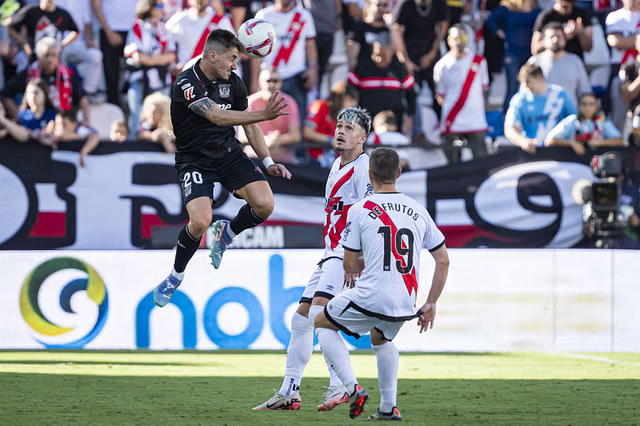rayo vallecano vs cd leganés lineups: Full Match Lineup and Tactical Breakdown
The matchup between Rayo Vallecano and CD Leganés offered a tactical showcase marked by structured formations and a tightly contested battle in midfield. In matches like this, understanding the starting lineups and tactical approaches is crucial. This guide walks through the full lineups, formations, and player roles that shaped the outcome of the game.
Starting Lineups
Both teams took to the pitch with distinct formations that reflected their season-long strategies. Let’s break down who started and how they were positioned.
Rayo Vallecano (4-2-3-1 Formation)
-
Goalkeeper: Augusto Batalla
-
Defenders: Andrei Ratiu (Right Back), Florian Lejeune, Abdul Mumin (Center Backs), Pep Chavarría (Left Back)
-
Midfielders: Pathé Ciss, Unai López (Double Pivot)
-
Attacking Midfielders: Jorge de Frutos (Right Wing), Isi Palazón (Central Attacking Midfield), Álvaro García (Left Wing)
-
Forward: Randy Nteka
Rayo focused on maintaining control in the center with a solid midfield pairing, while relying on wide pace and a central creative presence to unlock the defense.
CD Leganés (4-4-2 Formation)
-
Goalkeeper: Marko Dmitrović
-
Defenders: Sergio González, Matija Nastasić, Allan Nyom, Adria Altimira
-
Midfielders: Juan Cruz, Yvan Neyou, Darko Brasanac, Seydouba Cissé
-
Forwards: Miguel de la Fuente, Munir El Haddadi
Leganés opted for a classic flat 4-4-2 formation, aiming for stability in midfield and quick transitions from defense to attack.
Tactical Analysis
The contrasting formations created an intriguing tactical battle. Rayo Vallecano sought to dominate the ball and create overloads on the flanks, while Leganés attempted to stay compact and hit on the counter.
Rayo Vallecano’s Strategy
With the 4-2-3-1 shape, Rayo built from the back and used their double pivot to maintain midfield control. The wide attackers stayed high and wide, providing passing lanes and stretching Leganés’ back line. The attacking midfielder operated in tight spaces between lines, distributing passes and initiating pressing traps when possession was lost.
This structure helped Rayo retain more possession and apply consistent pressure on Leganés throughout the match.
CD Leganés’ Setup
Leganés, on the other hand, adopted a more reactive approach. Their midfield line remained disciplined, denying central space to the opposition. Quick outlet passes toward their front two aimed to exploit defensive gaps when Rayo pushed forward. However, the lack of width in their build-up limited their attacking threat.
Despite staying compact and organized for much of the match, Leganés struggled to create clear chances.
Key Substitutions
In the second half, both teams made changes to adjust the tempo and freshen up tired legs.
-
Rayo introduced energy on the flanks and added a box-to-box presence to capitalize on Leganés’ declining shape.
-
Leganés turned to their bench to reinforce the midfield and add a target man up front, aiming to shift momentum, though their adjustments had minimal impact on the result.
Match-Winning Moment
The breakthrough came late in the match when Rayo’s central midfielder, Pathé Ciss, found space in front of the back line and struck a low shot into the bottom corner. It was a reward for Rayo’s persistent attacking shape and pressure.
Frequently Asked Questions
What formation did Rayo Vallecano use?
Rayo lined up in a 4-2-3-1 formation with an emphasis on midfield control and wide attacking play.
What was CD Leganés’ tactical approach?
Leganés used a 4-4-2 setup focused on defensive organization and quick transitions.
Who were the key players?
Pathé Ciss stood out for his defensive composure and attacking contribution. Álvaro García and Isi Palazón also added creativity and pace for Rayo.
Which team had more possession?
Rayo Vallecano dominated possession due to their structured build-up play and central midfield control.
Did substitutions change the flow of the game?
Rayo’s substitutions added fresh energy and helped maintain pressure, contributing to their late goal. Leganés’ changes had limited influence.
Final Thoughts
The rayo vallecano vs cd leganés lineups reflect two different football philosophies—Rayo’s dynamic midfield-driven approach versus Leganés’ structured and cautious setup. Ultimately, Rayo’s tactical discipline, ball retention, and ability to adapt proved decisive.
Understanding lineups is more than just knowing who started; it’s about how systems interact and influence the match. This encounter served as a clear example of how formation choices and player roles can define the outcome of a tightly contested game.
